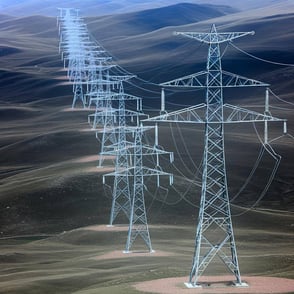Thermal Energy Storage
Thermal energy storage (TES) stores heat or cold for later use, enhancing energy efficiency, supporting renewables, and reducing costs and emissions in HVAC, industrial, and power systems.
What is Thermal Energy Storage?
Thermal energy storage (TES) is a type of energy storage system that stores energy in the form of heat or cold, allowing for the retention and later use of thermal energy. This technology can store energy for a few hours to several months, providing a flexible and efficient solution for balancing energy supply and demand. Heat storage is widely used in various applications, including heating, ventilation, air conditioning (HVAC) systems, industrial processes, and renewable energy integration.
How Thermal Energy Storage Works
TES systems store excess thermal energy when available and release it when needed. The process involves three main components: a storage medium, a heat transfer mechanism, and an insulated container. The choice of storage medium depends on the specific application and desired storage duration. Common storage media include water, ice, molten salts, and phase change materials (PCMs). Heat transfer fluids (HTFs) such as water, glycol, or oil are used to transfer thermal energy between the source, the storage medium, and the end-use application. The storage medium and HTF are housed in an insulated container to minimize thermal losses and maintain the desired temperature. These containers vary in size and design, from small tanks for residential use to large reservoirs for industrial applications.
There are several types of TES systems, each with its own advantages and applications: Sensible heat storage stores thermal energy by raising the temperature of a solid or liquid storage medium. Common examples include water tanks, concrete, and rock beds. Latent heat storage uses phase change materials (PCMs) that absorb and release thermal energy during phase transitions, such as melting and solidifying. Latent heat storage systems have high energy density and are used in HVAC systems, building materials, and industrial processes. Thermochemical storage stores thermal energy through reversible chemical reactions. When heat is applied, the chemical reaction stores energy, which can be released later by reversing the reaction.
Converting Stored Thermal Energy to Electricity
Heat storage systems can convert stored thermal energy into heat. However, some also have the ability to convert thermal energy back into electricity using technologies like thermophotovoltaics (TPV). TPV systems convert infrared radiation (heat) into electricity, similar to how photovoltaic (PV) cells convert sunlight.
In a typical TPV system, heat stored in a material at high temperatures (usually between 1200°C and 1600°C) radiates thermal photons. These photons are captured by thermophotovoltaic cells, which convert the thermal energy into electrical energy. Recent advancements have significantly improved TPV efficiency, making it a viable option for high-temperature storage applications. Advanced materials and structures, such as air-bridge thermophotovoltaic cells, further enhance this conversion process by capturing a broader range of photon energies and recycling non-converted photons.
The Impact of Thermal Energy Storage on the Energy Sector
TES systems have a wide range of applications across various sectors. TES is widely used in heating, ventilation, and air conditioning systems to store and manage thermal energy for residential, commercial, and industrial buildings. TES is also used in manufacturing, chemical production, and food processing, enhancing process efficiency and reducing energy consumption.
Also increasing efficiency, thermal storage systems are integrated with power plants to store excess thermal energy generated during off-peak hours and release it during peak demand, optimizing operations. TES supports the integration of renewable energy sources by storing excess thermal energy and providing a consistent power supply, mitigating the intermittency of renewable energy generation.
TES systems offer cost-effective energy storage solutions by reducing peak demand charges and lowering operational costs. They can defer the need for expensive infrastructure upgrades and reduce the overall cost of energy production. TES systems contribute to environmental sustainability by reducing greenhouse gas emissions and decreasing reliance on fossil fuels. By optimizing energy use and supporting renewable energy integration, TES systems help lower the carbon footprint of the energy sector and promote a cleaner environment.
Conclusion
Thermal energy storage is a versatile and efficient technology that plays a crucial role in modern energy systems. By storing and managing thermal energy, TES systems enhance energy efficiency, support renewable energy integration, and provide economic and environmental benefits. As the demand for clean and reliable energy continues to grow, thermal energy storage systems will become increasingly important in ensuring a sustainable and resilient energy future.
Glossary
- Thermal Energy Storage (TES): A technology that stores energy in the form of heat or cold, allowing for the retention and later use of thermal energy.
- Storage Medium: The material used to store thermal energy in a TES system, such as water, ice, molten salts, or phase change materials (PCMs).
- Heat Transfer Fluid (HTF): A fluid used to transfer thermal energy between the source, storage medium, and end-use application in a TES system.
- Insulated Container: A container that houses the storage medium and HTF in a TES system, designed to minimize thermal losses and maintain the desired temperature.
- Sensible Heat Storage: A method of storing thermal energy by raising the temperature of a solid or liquid storage medium.
- Latent Heat Storage: A method of storing thermal energy using phase change materials (PCMs) that absorb and release energy during phase transitions.
- Thermochemical Storage: A method of storing thermal energy through reversible chemical reactions.
- HVAC Systems: Heating, ventilation, and air conditioning systems used to control the climate in residential, commercial, and industrial buildings.
- Renewable Energy Integration: The process of incorporating renewable energy sources such as solar and wind power into the energy grid.
- Greenhouse Gas Emissions: Gases released into the atmosphere that contribute to the greenhouse effect and global warming, such as carbon dioxide and methane.
.png?width=200&height=80&name=etpa-logo-color%20(1).png)































.png)
.png)
-1.png?width=250&height=100&name=etpa-logo-color%20(1)-1.png)